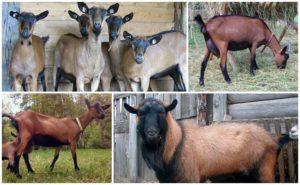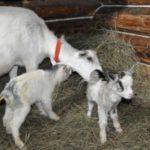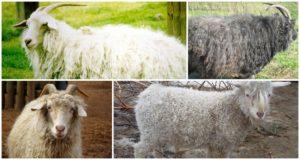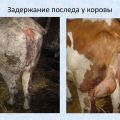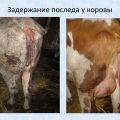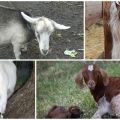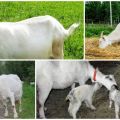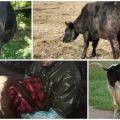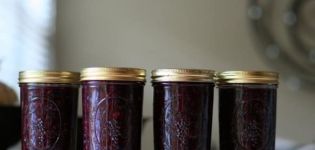Why the goat does not get the afterbirth and what to do, folk methods and prevention
The afterbirth is the shell of the embryo, which consists of the placenta, watery, mucous secretions and blood. The kid feeds through the biological membrane while in the womb. After his birth, the placenta, mucus and fluid are released. Sometimes the goat's afterbirth does not leave - it remains inside or hangs outside. It can be separated independently - with the help of medicines and folk remedies.
Why does the goat not leave the afterbirth?
The placenta is naturally separated within three to six hours after birth and when the mother feeds the kids. The shell does not come out for a long time for the following reasons:
| Name | Features: |
| Multiplicity | Distension of the uterus and accumulation of large amounts of amniotic fluid delay the passage of the placenta |
| Excess weight | Being overweight reduces fertility and increases the likelihood of postpartum complications |
| Lack of vitamins and minerals | Avitaminosis develops as a result of improper nutrition |
| Genetic pathology as a result of intimate relationship | Mating of closely related animals leads to abnormal development of the fetus, physical defects in pups and retained placenta |
| Weakening of the walls of the uterus | Weak muscles are possessed by goats, which are not allowed out of the barn, living on a leash |
| Infection | Lack of hygiene in the barn leads to infection of the animal |
| Non-corruption | In primiparous goats, milk appears after childbirth, and the afterbirth leaves after the first feeding of the young. The goat needs to be milked more often to make it easier to waste the biological membrane and get more milk. |
The farmer has 24 hours to help the goat get rid of the placenta. If the amniotic sac does not come out for a maximum of 2 days, the animal develops endometritis - inflammation of the mucous walls of the uterus. The condition is accompanied by purulent bloody discharge with an unpleasant odor. The sedentary lifestyle of goats, unhealthy diet and low immunity predispose to inflammatory processes. With the development of endometritis, the risk of developing sepsis is high.
What medical care to provide a goat
With a long delay in the amniotic sac, it is better to call a veterinarian. But in rural areas, the doctor is not always nearby.Breeders try to solve an unpleasant problem on their own, without distracting the specialist from a more serious challenge. Home methods help get rid of the placenta within 24 hours. If you could not help the goat on your own, and the animal became worse, then you cannot do without the help of a veterinarian.

We increase the contractile capabilities of the uterus
If the afterbirth has not departed, the contractions of the uterine walls are stimulated with medications:
- "Oxytocin" is a hormone produced by the body. The solution is sold in a veterinary and a regular pharmacy, injected intramuscularly in the evening after milking. The dosage should be checked with your veterinarian. A small dose of a young goat is enough - 0.5 milliliters of the drug. General recommendations for administration - 1 milliliter in the morning and evening for three days;
- "Dicinon" - the solution strengthens blood vessels and increases blood clotting, sold in ampoules of 2 milliliters. The approximate dose is 6 milliliters per day. The course also lasts 3 days;
- "Vikasol" - a substitute for "Ditsinon" with a similar effect, injected 2 times a day for three days;
- "Bicillin-3" is a powder antibiotic, diluted with saline. The dosage is calculated based on the weight of the animal. The injection is given once a day to prevent bacterial infection.
It is dangerous to prescribe the antibiotic dose on your own. Exceeding the concentration of the drug in the blood weakens the liver and kidneys. The three-day course should be continued even if the outer part of the placenta is leaving, since unseparated parts of the placenta may remain inside. In difficult cases, veterinarians inject antibiotics into the uterus: "Rifacyclin", "Norsulfazole".
If childbirth is expected in several goats, it is better to stock up on "Oxytocin" or its analogue - "Oksylat". In an emergency, the drug will alleviate the condition of the animals before the arrival of the veterinarian. Also, the doctor should be warned about the measures taken.
Cleansing the uterus from the placenta
If the uterus has not been cleansed naturally, the afterbirth is pulled out by hand. After giving birth, it usually hangs outside like an empty bag. How to remove the afterbirth:
- disinfect the lower abdomen of the goat and the hanging placenta with a manganese solution;
- wear sterile medical gloves;
- pull the afterbirth with smooth movements.
It is important not to tear off the placenta near the anus. The part left inside is difficult to remove at home. If the afterbirth cannot be pulled out by hand, you should also call your veterinarian. It is important to do the procedure with patience and care. You cannot pull strongly, otherwise the uterus will fall out.
Experienced breeders use the method of pulling out puppies and afterbirth in dogs:
- lift the goat by the front legs;
- press on the stomach towards the tail;
- carefully pull the afterbirth.

Reception must be done together or three. Also, goat breeders immerse their hand inside the uterus, find the remnants of the placenta by touch and pull it out. In the absence of experience, it is better not to use methods of cleansing the uterus. An inexperienced hand can hurt an animal. The procedure requires maximum sterility so as not to introduce bacteria. Otherwise, the uterus will become inflamed and sepsis will develop.
To remove intrauterine placental residues, use "Ichthyol" or "Furazolidone" in the form of vaginal suppositories. But their introduction is made difficult by the fact that the goat does not allow itself to come. Experienced goat breeders advise against tying the animal. Better to ask an assistant to hold the goat.
It is also necessary to introduce a candle with sterile gloves, having previously lubricated them with petroleum jelly or petroleum jelly boiled for half an hour. It is recommended to entrust the procedure to a hostess with strong nerves. The female hand is smaller and lighter.
The animal can kick in pain, so there is no need to force candles. For small breeds, vaginal suppositories are dangerous. It is better to take them to the clinic, where the cleaning procedure will be carried out by inserting a catheter.
Cleansing the uterus is not a priority.First you need to try more gentle folk methods or give an injection of oxytocin.
Introduction of important trace elements and vitamins
Foods with a high content of vitamins are added to the diet after lambing:
- roots;
- pumpkin;
- zucchini;
- enriched compound feed;
- young apple, cherry twigs;
- meadow grasses.
The delay of the placenta is caused by the unbalanced content of carotene and calcium in the daily diet. Carotene is involved in the synthesis of vitamin A, which is essential for the health of the uterine lining. Lack of vitamin A leads to keratinization of the mucous membrane. The source of the substance is hay from cereals and legumes in the amount of one and a half kilograms per day.
Vitamin C is needed to clot blood and increase immunity. For strong contractions that push the fetus with the shell, calcium is required. Drug treatment is combined with vitamin injections if the reason for the delay in the placenta is vitamin deficiency and poor nutrition before childbirth. If the reason for the delay is different, the animal will develop hypervitaminosis from a vitamin cocktail.
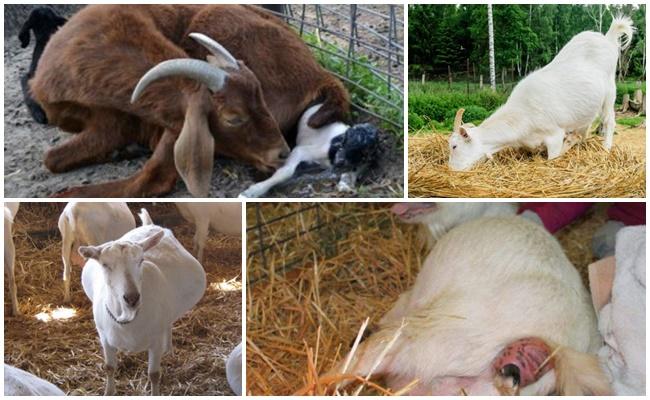
Activity of the giving birth goat
If the delay of the placenta passes without complications, the goat is taken for a walk. The movement helps to free the uterus from the remnants of the fetal membrane. Walking is used as an additional way to help. If the goat is doing well, you can combine walks with traditional methods. But it is important to remember that the time for placenta separation is limited to days. After the allotted time, you need to call the veterinarian, even if the animal does not show concern.
Traditional methods
To facilitate the discharge of the placenta, the following are effective:
- milking;
- phytotherapy;
- tying the placenta.
The knotted placenta leaves faster, and the release of milk triggers the mechanism of the natural exit of the amniotic sac. Farmers notice that udders are unpleasant for goats before giving birth. But after giving birth, animals that are accustomed to the hands of their owners better tolerate the first milking.
A medicinal drink is prepared for a woman in labor:
- a decoction of nettle leaves or onion husks - nettles can be given fresh, after pouring boiling water over them, and salt and sugar are added to the husks;
- warm boiled sweet water - dissolve 2 cups of sugar in a liter of water;
- flax decoction - brew 25 grams of seeds per 250 milliliters of boiling water and give to drink one hour after lambing.
- colostrum - 300 grams of sugar is dissolved in 200 milliliters of milk after childbirth and the goat is fed.
Flaxseed water can be added to sweet water. Colostrum stimulates the muscles of the uterus. Even after milking 200 milliliters of colostrum from a first-born goat, after a few hours you can find an afterbirth in the litter.
In folk practice, an infusion of the following components is used:
- sunflower baskets - 4 pieces;
- onion husks - 4 cups;
- ergot - 20 grams;
- sugar - 1 glass;
- water - 3 liters.
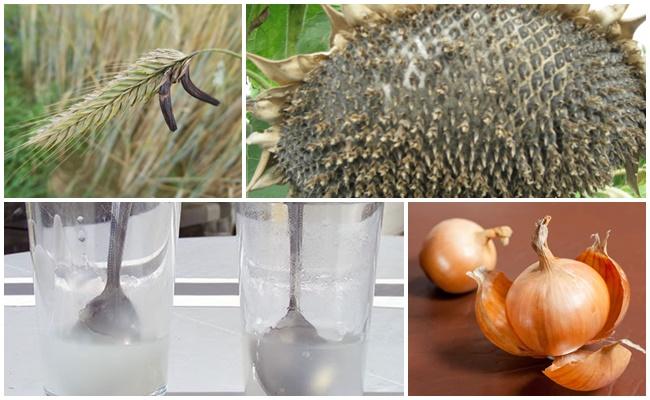
Mix the ingredients and boil, add sugar and bring the volume to ten liters with water. The infusion promotes the rapid release of the placenta. It is given to the goat to drink after lambing. Another effective folk method that is used with a long delay in the placenta is a salt enema. 20 grams of salt is dissolved in two liters of water slightly warmer than room temperature. The solution is poured into a rubber bulb with a soft tip and injected into the uterus. The afterbirth leaves within three hours.
Salt is also added to drinking water. The saline solution helps restore electrolyte balance in the goat's body during blood loss and thirst.
Preventive actions
To prevent possible complications, it is better to invite a veterinarian for the first birth. For prevention, changes should be made to prenatal animal care:
- change the diet - feed the goat with ready-made concentrates before giving birth;
- launch - the gradual abolition of milking begins a month and a half before birth;
- do not overfeed - obesity leads to the death of kids in the womb, difficult childbirth;
- maintain physical activity - sedentary, overweight animals do not tolerate labor pains;
- keep the barn clean - change the bedding every three days, ventilate the room, heat it in winter and prevent the spread of dampness.
After giving birth, which took place in the absence of the owners, you need to look for the placenta on the litter in the barn. Sometimes goats eat the afterbirth. If the remnants of the shell do not hang down on the back of the goat and are not on the straw, call a doctor. Without an accurate determination of the location of the amniotic sac, you should not treat the goat with medications and cleanse the uterus yourself before the veterinarian arrives.
